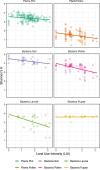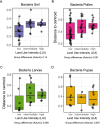Direct and indirect effects of land use on microbiomes of trap-nesting solitary bee larvae and nests
- PMID: 39845038
- PMCID: PMC11753253
- DOI: 10.3389/fmicb.2024.1513096
Direct and indirect effects of land use on microbiomes of trap-nesting solitary bee larvae and nests
Abstract
Introduction: The global decline in biodiversity and insect populations highlights the urgent need to conserve ecosystem functions, such as plant pollination by solitary bees. Human activities, particularly agricultural intensification, pose significant threats to these essential services. Changes in land use alter resource and nest site availability, pesticide exposure and other factors impacting the richness, diversity, and health of solitary bee species. In this study, we investigated yet another facet currently less well investigated in such context: Microbial communities associated with wild bees play crucial roles in larval development, metabolism, immunity and overall bee health. However, the drivers and dynamics of healthy microbiome in solitary bees are still poorly understood, especially regarding the direct and indirect effects of land use on the diversity and composition of these microbial communities.
Methods: We examined bacterial communities in the offspring and nest materials of the Megachilid trap-nesting solitary bee, Osmia bicornis, along a gradient of land use intensification by 16S rRNA gene metabarcoding. Given that landscape composition, climatic conditions, and food resources are known to influence microbial compositions in solitary bee species, we hypothesized that land use changes would alter resources available for food and nest material collection and thereby affecting the microbiomes in offspring and their nest environments. We anticipated reduced microbial diversity and altered composition with increased land use intensification, which is known to decrease the number and diversity of resources, including the pool of floral and soil bacteria in the surrounding environment.
Results: As expected, we observed significant shifts in the bacterial composition and diversity of bees and their nests across varying degrees of land use intensity, differing in management types and the availability of flowers. The Shannon diversity of bacteria in nest materials (larval pollen provision, soil nest enclosure) and larval guts decreased with increasing land use intensity. However, the pupae microbiome remained unaffected, indicating a reorganization of the microbiome during metamorphosis, which is not significantly influenced by land use and available resources.
Discussion: Our findings provide new insights into the factors shaping environmental transmission and changes in solitary bee microbiomes. This understanding is crucial for comprehending the impacts of intensive land use on wild bee health and developing strategies to mitigate these effects.
Keywords: Biodiversity Exploratories; Osmia bicornis; grasslands; metabarcoding; pollination; solitary bee microbiome.
Copyright © 2025 Peters, Leonhardt, Schloter and Keller.
Conflict of interest statement
The authors declare that the research was conducted in the absence of any commercial or financial relationships that could be construed as a potential conflict of interest.
Figures




Similar articles
-
Diets maintained in a changing world: Does land-use intensification alter wild bee communities by selecting for flexible generalists?Ecol Evol. 2022 May 15;12(5):e8919. doi: 10.1002/ece3.8919. eCollection 2022 May. Ecol Evol. 2022. PMID: 35600696 Free PMC article.
-
Harvesting effects on wild bee communities in bioenergy grasslands depend on nesting guild.Ecol Appl. 2019 Mar;29(2):e01828. doi: 10.1002/eap.1828. Epub 2018 Dec 26. Ecol Appl. 2019. PMID: 30412332
-
Susceptibility of Red Mason Bee Larvae to Bacterial Threats Due to Microbiome Exchange with Imported Pollen Provisions.Insects. 2020 Jun 15;11(6):373. doi: 10.3390/insects11060373. Insects. 2020. PMID: 32549328 Free PMC article.
-
Influence of Nesting Characteristics on Health of Wild Bee Communities.Annu Rev Entomol. 2020 Jan 7;65:39-56. doi: 10.1146/annurev-ento-011019-024955. Annu Rev Entomol. 2020. PMID: 31923377 Review.
-
Environmental Effects on Bee Microbiota.Microb Ecol. 2023 Oct;86(3):1487-1498. doi: 10.1007/s00248-023-02226-6. Epub 2023 Apr 26. Microb Ecol. 2023. PMID: 37099156 Review.
References
-
- Alvarez-Pérez S., Lievens B., Jacquemyn H., Herrera C. (2012). Acinetobacter nectaris sp. nov. and Acinetobacter boissieri sp. nov., isolated from floral nectar of wild Mediterranean insect-pollinated plants. Int. J. Syst. Evol. Microbiol. 63, 1532–1539. doi: 10.1099/ijs.0.043489-0, PMID: - DOI - PubMed
-
- Amiet F. (2017). Hymenoptera Apidae, 1. Teil – Allgemeiner Teil, Gattungsschlüssel, Die Gattungen Apis, Bombus und Psithyrus. SEG, Lausanne: Fauna Helvetica, Band; 29.
-
- Anderson K., Sheehan T. H., Eckholm B., Mott B. M., Degrandi-Hoffman G. (2011). An emerging paradigm of colony health: microbial balance of the honey bee and hive (Apis mellifera). Insect. Soc. 58, 431–444. doi: 10.1007/s00040-011-0194-6 - DOI
-
- Bates D., Maechler M., Bolker B., Walker S. (2015). lme4: Linear mixed-effects models using Eigen and S4.
LinkOut - more resources
Full Text Sources
Research Materials

